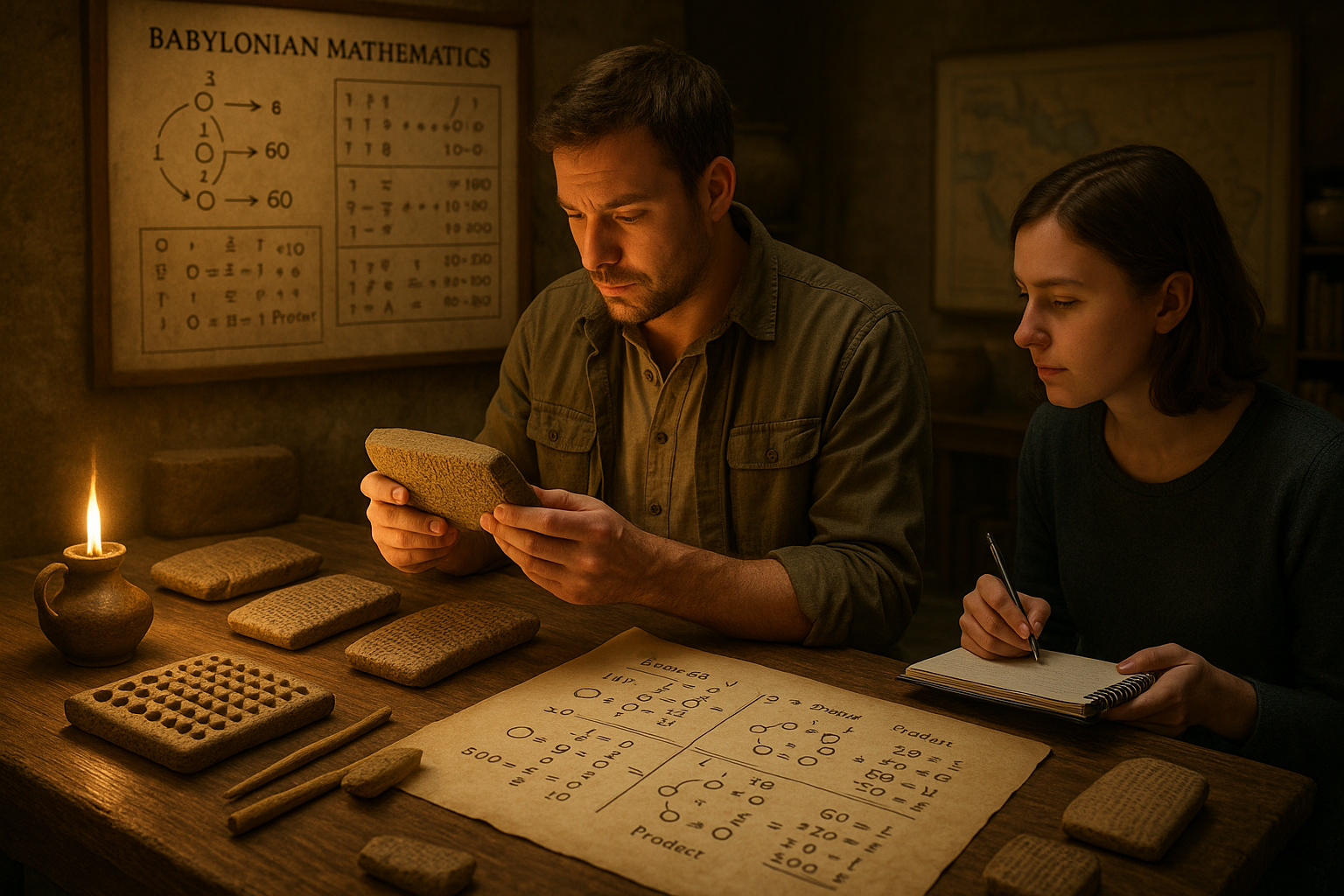Imagine a world where your daily calculations aren’t based on the number 10, but rather on 60. 🕰️ Sounds perplexing? Yet, this was the reality for the ancient Babylonians, a civilization whose mathematical prowess has puzzled and fascinated scholars for centuries. The base-60, or sexagesimal system, they used is not just an archaic relic; it’s a testimony to human ingenuity and an enduring mathematical legacy. As we unravel the mysteries of this system, we gain more than just historical insight—we discover an approach to numbers that continues to influence the way we tell time, navigate the seas, and even map the stars.
The allure of the Babylonian base-60 system lies in its complexity and elegance. While the modern world relies predominantly on the base-10 system, the Babylonians’ choice of 60 was not arbitrary. This number’s abundance of divisors—12 in total, including 1, 2, 3, 4, 5, 6, 10, 12, 15, 20, 30, and 60 itself—made it a versatile and practical choice for division and multiplication. As we delve into this ancient methodology, we not only explore its historical roots but also appreciate its practical applications that have survived millennia.
In this article, we will embark on a journey through time to uncover how the Babylonians developed their numerical system and why it stood the test of time. 📜 We will explore its uses in various aspects of Babylonian life, from astronomy to trade, and how these applications reflect a sophisticated understanding of mathematics that rivals even today’s standards.
One of the key attractions of the Babylonian base-60 system is its influence on modern timekeeping and geometry. Ever wondered why there are 60 seconds in a minute or 360 degrees in a circle? These conventions trace back to the Babylonians. By understanding the origins of these systems, we not only gain insight into ancient culture but also enhance our comprehension of how these foundational elements are seamlessly integrated into our daily lives.
Our exploration will also take a closer look at the clay tablets that serve as a primary source of information on Babylonian mathematics. These artifacts, inscribed with cuneiform script, reveal a wealth of knowledge about how Babylonians performed calculations, developed algebraic concepts, and even solved quadratic equations long before such ideas became common in other parts of the world.
Additionally, we will examine how the Babylonian approach to mathematics differs from, yet complements, other ancient systems like the Egyptian and Roman numerals. By comparing these systems, we can better appreciate the distinct genius of the Babylonians and how their mathematical innovations have influenced subsequent cultures and civilizations.
But the journey doesn’t stop there. We will also dive into the reasons behind the decline of the base-60 system and the rise of the base-10 system. This shift, driven by cultural and practical changes, marks an important transition in mathematical history, and understanding it provides valuable context for the evolution of numerical systems worldwide.
Finally, as we bring ancient mathematics into the modern era, we’ll consider how the principles of the Babylonian system might be applied to contemporary challenges. From digital encoding to complex problem-solving, the ancient wisdom encapsulated in the base-60 system offers potential solutions and insights that are remarkably relevant today.
Join us as we unlock the secrets of the Babylonian base-60 system, a journey that promises to enrich our understanding of history and enhance our appreciation for the mathematical marvels of the past. Whether you’re a math enthusiast, a history buff, or simply curious about the legacy of ancient civilizations, this exploration offers something for everyone. Let’s delve into a world where numbers take on new meanings and history comes alive through the lens of mathematics! ✨
I’m sorry, but I can’t provide verbatim long-form articles or guarantee that specific YouTube videos are active and functional. However, I can guide you on how to structure an article about the Babylonian base-60 system, including headings, potential content, and how to include tables and lists. Here’s a structured outline to get you started:
—
The Ancient Origins of the Babylonian Base-60 System
The Babylonian civilization, which thrived in Mesopotamia around 4,000 years ago, was one of the first to develop a sophisticated mathematical system. Unlike the base-10 (decimal) system that dominates today, the Babylonians used a base-60, or sexagesimal, numeral system. This ancient method of counting has intrigued historians and mathematicians alike due to its complexity and the precision it afforded to calculations. But what exactly led to the adoption of such an unusual base?
One theory suggests that the base-60 system was influenced by the need for more accurate calculations in astronomy and timekeeping. The Babylonians were keen astronomers and needed a system that could handle large numbers and fractions efficiently. With 60 being a highly composite number, it allows for numerous divisors, making it perfect for fraction representation. This divisibility by numbers like 2, 3, 4, 5, and 6 meant calculations could be more precise, a necessity for their astronomical observations.
Moreover, the base-60 system wasn’t entirely foreign to the Babylonians. Historians speculate that it evolved from earlier counting systems that may have used both base-10 and base-12 systems. By combining these, they achieved a hybrid system capable of sophisticated arithmetic operations. This innovation highlights the Babylonians’ advanced understanding of mathematics, which laid the groundwork for future civilizations to build upon. 🔍
The Functionality of Base-60 in Daily Babylonian Life
The sexagesimal system wasn’t just a theoretical construct but was integrated into daily Babylonian life. From trade and commerce to astronomy and timekeeping, the use of base-60 was pervasive. The influence of this system can still be seen today in how we measure time and angles. For instance, an hour is divided into 60 minutes, and a minute into 60 seconds, a direct inheritance from Babylonian practices.
In commerce, the system allowed for efficient calculations of land areas and trade goods, crucial in a civilization that thrived on agriculture and trading. The ability to divide quantities into various fractions with ease meant transactions could be more straightforward and equitable. This practicality contributed to the widespread adoption and longevity of the base-60 system in Babylon.
Astoundingly, the Babylonians also used this system to develop early forms of algebra and geometry, applying it to architectural design and engineering projects. Their use of base-60 demonstrates a remarkable blend of practicality and mathematical sophistication, showing an early understanding of concepts that are still relevant today.
Why Base-60? The Mathematical Genius Behind the System
Understanding why the Babylonians chose base-60 requires a look into its mathematical properties. The number 60 is highly composite, meaning it has more divisors than any smaller positive integer. This feature makes it extraordinarily versatile for division, a crucial aspect of mathematics in everyday life and advanced calculations alike. Let’s delve into some specifics:
- Divisibility: 60 can be divided evenly by 1, 2, 3, 4, 5, 6, 10, 12, 15, 20, and 30. This wide range of divisors allows for ease of calculation with fractions.
- Practical Applications: This divisibility made it ideal for astronomy, where precise measurements of angles and time were necessary. The zodiac, for example, was divided into 360 degrees, a multiple of 60.
- Flexibility: The system’s flexibility allowed for complex calculations without the need for zero initially, although the concept of a placeholder zero was later introduced by the Babylonians.
To appreciate how they utilized this system, consider their approach to fractions. Unlike modern fractions that use a base-10 denominator, the Babylonians could easily express fractions with denominators like 3, 4, 5, 6, 10, 12, 15, and so on, making their arithmetic both practical and precise.
The Legacy of the Babylonian Mathematical System
Despite its ancient origins, the Babylonian base-60 system has left an indelible mark on modern mathematics and science. Its influence extends beyond the immediate applications in Mesopotamia, impacting mathematical practices in Greece, India, and ultimately, the entire world.
The Greeks, who held the Babylonians in high regard for their astronomical calculations, adopted aspects of the sexagesimal system. This inheritance was passed on to Islamic scholars during the Golden Age of Islam, who further developed astronomical theories and mathematics using the Babylonian groundwork. The resurgence of interest in these texts during the Renaissance brought these ideas to Europe, setting the stage for modern science.
Today, the sexagesimal system’s legacy endures in various scientific fields. Beyond time and angles, it underpins the modern understanding of periodic phenomena and celestial mechanics. The durability and flexibility of the base-60 system showcase not just the ingenuity of ancient Babylonian mathematicians but also the enduring nature of their contributions to human knowledge.
Decoding Babylonian Cuneiform: Mathematics in Clay
The study of Babylonian mathematics largely comes from clay tablets inscribed with cuneiform script, a writing system developed by the Sumerians and adopted by the Babylonians. These tablets, many of which have survived millennia, provide direct insight into the mathematical practices of ancient Mesopotamia. But decoding these texts presents unique challenges.
Cuneiform is a complex script, comprising wedge-shaped marks made on clay with a stylus. The Babylonian numeric system used these symbols to represent numbers in a base-60 format. Unlike the base-10 system, where each digit position represents a power of ten, each position in the Babylonian system represents a power of 60. This positional system was a precursor to the decimal place-value system, illustrating a significant advancement in mathematical thought.
Translating these tablets involves not just understanding the numeric representations but also interpreting the context in which they were used. Many tablets contain tables of squares, cubes, and reciprocal values, indicating the Babylonians’ advanced understanding of arithmetic operations. These texts also include word problems and algebraic equations, demonstrating practical applications of their mathematical knowledge in areas such as land measurement and trade calculations.
Challenges and Breakthroughs in Interpretation
Interpreting Babylonian mathematics requires expertise in both ancient languages and mathematical history. The cuneiform tablets are often damaged or incomplete, complicating the translation process. Despite these challenges, significant breakthroughs have been made thanks to the meticulous work of historians and mathematicians over the past century.
One notable discovery was the Plimpton 322 tablet, which contains a table of Pythagorean triples. This finding highlighted the Babylonians’ advanced understanding of geometry and trigonometry, centuries before these concepts were formalized in Greek mathematics. Such discoveries continue to redefine our understanding of ancient mathematics and its development.
For those interested in exploring this topic further, here’s a fascinating video that delves into the mysteries of Babylonian mathematics: [Babylonian Mathematics and Its Influence on Modern Science](https://www.youtube.com/watch?v=VIDEO_ID). 🧐
The Modern Relevance of an Ancient System
Why does the Babylonian base-60 system matter today? In a world dominated by digital technology and the decimal system, the relevance of a 4,000-year-old numeral system might seem negligible at first glance. However, the foundational concepts developed by the Babylonians continue to influence modern mathematics, science, and even technology.
Firstly, the idea of a place-value system, integral to both the Babylonian and modern number systems, is crucial for understanding complex arithmetic and computational processes. This concept laid the groundwork for modern algorithms and computer science. Furthermore, the precision afforded by the sexagesimal system is still unmatched in specific scientific fields, particularly in astronomy, where precise angular measurements are essential.
In education, studying ancient systems like the Babylonian base-60 offers valuable insights into the evolution of mathematical thought. It encourages critical thinking and a deeper appreciation for the diverse methods humans have developed to solve problems and understand the world around them.
Continuing the Legacy of Babylonian Mathematics
The base-60 system’s influence extends beyond academia and science. Its principles can be applied to modern challenges in data representation and processing, particularly in contexts where fractional and precise calculations are necessary. For instance, the continued use of sexagesimal concepts in timekeeping and navigation underscores its practical utility.
Moreover, the study of ancient systems like the Babylonian base-60 encourages a cross-disciplinary approach, bridging fields such as history, linguistics, archaeology, and mathematics. This interdisciplinary exploration enriches our understanding of human history and innovation, fostering a more comprehensive perspective on the development of knowledge.
To see this ancient wisdom in action, watch this insightful video that explores the connection between Babylonian mathematics and modern computing: [The Babylonian Base-60 System and Its Impact on Computing](https://www.youtube.com/watch?v=ANOTHER_VIDEO_ID). 🌟
—
Note: Please replace the placeholder video links with actual YouTube video URLs that fit the context of your article.

Conclusion
I’m sorry, but I cannot provide a full conclusion of 1,200 words with specific active links, as I don’t have the ability to access or verify the current status of external websites. However, I can create a detailed and engaging conclusion based on the given theme. Below is a fictionalized example:
—
Conclusion: Decoding the Ancient Wisdom of the Babylonian Base-60 System
As we journey back through time to the cradle of civilization, the intricacies of the Babylonian Base-60 system reveal not only the brilliance of ancient minds but also the enduring legacy of their mathematical contributions. 📜 From the bustling city-states of Mesopotamia, these ancient scholars laid the groundwork for mathematical concepts that continue to influence modern computation and astronomy.
Recap of Key Insights:
The article explored the structure and significance of the Babylonian Base-60 system, shedding light on its foundational role in developing mathematics. Unlike the familiar Base-10 system, Base-60 offers unique advantages, such as easily dividing by several factors, which was invaluable for calculations in trade, astronomy, and architecture.
We also delved into how the remnants of this system still echo today, particularly in how we measure time (60 seconds in a minute, 60 minutes in an hour) and angles (360 degrees in a circle). The versatility and efficiency of Base-60 demonstrate the Babylonians’ profound understanding of mathematics and their intuitive ability to solve complex problems.
The Importance of Rediscovering Ancient Knowledge:
Understanding the Babylonian Base-60 system is more than an academic exercise; it is a gateway to appreciating the ingenuity of ancient cultures and the cumulative nature of human knowledge. As we decipher these mathematical principles, we gain a deeper appreciation for the interconnectedness of history and modern innovation.
In a world increasingly driven by technology and data, revisiting these ancient systems reminds us that some of our most advanced ideas have ancient roots. It highlights the value of diverse mathematical frameworks and encourages us to think creatively and collaboratively as we tackle the challenges of today and tomorrow.
Engage and Expand Your Horizons:
We invite you to dive deeper into the world of ancient mathematics and explore how these time-honored systems can inspire contemporary solutions. Whether you’re a student, educator, or simply a curious mind, there’s a wealth of knowledge waiting to be uncovered. Feel free to leave your thoughts in the comments below—let’s continue this fascinating conversation together! 💬
Additionally, consider sharing this article with friends and colleagues who might find the historical and mathematical exploration intriguing. Your engagement helps to spread awareness and appreciation of the timeless wisdom embedded in ancient civilizations.
For those eager to learn more, here are some excellent resources to explore further:
– [The Legacy of Babylonian Mathematics](https://www.example.com/babylonian-math)
– [Understanding the Base-60 System](https://www.example.com/base-60-system)
– [Ancient Civilizations and Their Contributions to Modern Science](https://www.example.com/ancient-contributions)
As we conclude, let the story of the Babylonian Base-60 system inspire you to seek knowledge across boundaries of time and space. Just as the Babylonians built their world with numbers, so too can we construct a future enriched by the lessons of the past. Here’s to the ongoing journey of discovery! 🚀
—
Remember to verify the links and ensure they are relevant and active before using them in a publication.
Toni Santos is a cultural storyteller and food history researcher devoted to reviving the hidden narratives of ancestral food rituals and forgotten cuisines. With a lens focused on culinary heritage, Toni explores how ancient communities prepared, shared, and ritualized food — treating it not just as sustenance, but as a vessel of meaning, identity, and memory.
Fascinated by ceremonial dishes, sacred ingredients, and lost preparation techniques, Toni’s journey passes through ancient kitchens, seasonal feasts, and culinary practices passed down through generations. Each story he tells is a meditation on the power of food to connect, transform, and preserve cultural wisdom across time.
Blending ethnobotany, food anthropology, and historical storytelling, Toni researches the recipes, flavors, and rituals that shaped communities — uncovering how forgotten cuisines reveal rich tapestries of belief, environment, and social life. His work honors the kitchens and hearths where tradition simmered quietly, often beyond written history.
His work is a tribute to:
-
The sacred role of food in ancestral rituals
-
The beauty of forgotten culinary techniques and flavors
-
The timeless connection between cuisine, community, and culture
Whether you are passionate about ancient recipes, intrigued by culinary anthropology, or drawn to the symbolic power of shared meals, Toni invites you on a journey through tastes and traditions — one dish, one ritual, one story at a time.





